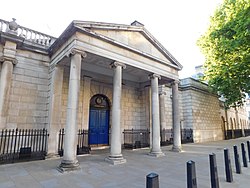Dover House
| Dover House | |
|
Middlesex | |
|---|---|
 Dover House, on Whitehall | |
| Type: | government building |
| Location | |
| Grid reference: | TQ30108002 |
| Location: | 51°30’15"N, 0°7’37"W |
| City: | Westminster |
| History | |
| Address: | Whitehall |
| Built 1750s | |
| For: | Sir Matthew Fetherstonhaugh, Bt. by James Paine |
| government building | |
| Neoclassical | |
| Information | |
| Owned by: | The Crown |
Dover House is a mansion in Whitehall which forms part of the government complex along that street, and which is the London headquarters of the Scotland Office. The building also houses the Office of the Advocate General for Scotland and the Independent Commission for Aid Impact.[1]
The building is is a Grade I listed building.[2]
History
Dover House was designed by James Paine as the London townhouse of Sir Matthew Fetherstonhaugh, 1st Baronet|Sir Matthew Fetherstonhaugh, Bt., a Member of Parliament, in the 1750s. It was remodelled by Henry Flitcroft, as "Montagu House", for George Montagu, created 1st Duke of Montagu, who had moved from nearby Bloomsbury. It was refurbished once again, by Henry Holland for the Prince Frederick, Duke of York, from 1788 to 1792. The building belonged to the Lamb family, Viscounts Melbourne, from 1793 to 1830.
The house has also been home to a French ambassador.
The most notable feature of Dover House is an entrance hall in the form of a rotunda inserted into the former forecourt by Holland, which is a unique entrance to a London mansion. The last private owners were the family of the Whig politician George James Welbore Agar-Ellis, created (1831) Baron Dover, whose title it has retained.
Government use
The Agar-Ellis heirs owned Dover House from 1830 to 1885, when it became the Scottish Office. Although mostly used for the Scottish Office, this building was used by the Colonial Office for several years from 1941 onwards. In 1946 the Glasgow Herald speculated that "It will not be many years before the building will be put to demolition and new Government offices raised on the site."[3] It was still in use by the Colonial Office when Zionist terrorists planted a bomb there in April 1947.[4]
Pictures
| ("Wikimedia Commons" has material about Dover House) |
Outside links
- Dover House entry from The DiCamillo Database of British & Irish Country Houses
- @Dover House page from the Survey of London]
References
- ↑ Independent Commission for Aid Impact: Contact
- ↑ National Heritage List 1066101: Dover House Scottish Office (Grade I listing)
- ↑ Accommodation for Scottish Office, Glasgow Herald, 12 October 1946, page 4
- ↑ Terror Through Time, Part 6 – The Murderous Mandate, BBC Radio 4, 1:45 PM, 14 October 2013
- Stourton, James (2012). Great Houses of London (Hardback). London: Frances Lincoln. ISBN 978-0-7112-3366-9.


